Dinosaur Park Formation
The Dinosaur Park Formation contains dense concentrations of dinosaur skeletons, both articulated and disarticulated, which are often found with preserved remains of soft tissues. Remains of other animals such as fish, turtles, and crocodilians, as well as plant remains, are also abundant. The formation has been named after Dinosaur Provincial Park, a UNESCO World Heritage Site where the formation is well exposed in the badlands that flank the Red Deer River.
Geological setting

The Dinosaur Park Formation is composed of sediments that were derived from the erosion of the mountains to the west. It was deposited on an alluvial to coastal plain by river systems that flowed eastward and southeastward to the Bearpaw Sea, a large inland sea that was part of the Western Interior Seaway. That sea gradually inundated the adjacent coastal plain, depositing the marine shales of the Bearpaw Formation on top of the Dinosaur Park Formation.
The Dinosaur Park Formation is about 70 metres (230 ft) thick at Dinosaur Park. The lower portion of the formation was laid down in fluvial channel environments and consists primarily of fine- to medium-grained, crossbedded sandstones. The upper portion, which was deposited in overbank and floodplain environments, consists primarily of massive to laminated, organic-rich mudstones with abundant root traces, and thin beds of bentonite. The Lethbridge Coal Zone, which consists of several seams of low-rank coal interbedded with mudstones and siltstones, marks the top of the formation.
The sediments of the Dinosaur Park Formation are similar to those of the underlying Oldman Formation and they were originally included in that formation. The two formations are separated by a regional disconformity, however, and are distinguished by petrographic and sedimentologic differences. In addition, articulated skeletal remains and bonebeds are rare in the Oldman Formation but abundant in the Dinosaur Park Formation.
Biostratigraphy
The Dinosaur Park Formation can be divided into at least two distinct faunas. The lower part of the formation is characterized by the abundance of Corythosaurus and Centrosaurus. This group of species is replaced higher in the formation by a different ornithischian fauna characterized by the presence of Lambeosaurus and Styracosaurus. The appearance of several new, rare species of ornithischian at the very top of the formation may indicate that a third distinct fauna had replaced the second during the transition into younger, non-Dinosaur Park sediments, at the same time an inland sea transgresses onto land, but there are fewer remains here. An unnamed pachyrhinosaur, Vagaceratops irvinensis, and Lambeosaurus magnicristatus may be more common in this third fauna.
The timeline below follows a synthesis presented by Fowler (2017) with additional information from Arbour et al. 2009, Evans et al. 2009, and Penkalski, 2013. Megaherbivore Assemblage Zones (MAZ) follow data presented by Mallon et al., 2012.

Fossil content
Amphibians
Remains of the following amphibians have been found in the formation:
Albanerpetontidae (extinct, salamander-like amphibians)
- Habrosaurus prodilatus
- Lisserpeton
- Opisthotriton kayi
- Scapherpeton tectum
- unnamed caudatan
- Two indeterminate caudatans
- Two unnamed salientans
- Tyrrellbatrachus brinkmani
- Hensonbatrachus kermiti
Dinosaurs

Remains of the following dinosaurs have been found in the formation:
Ornithischians
Remains of the following ornithischians have been found in the formation:
Ankylosaurs
| Ankylosaurs from the Dinosaur Park Formation | ||||||
|---|---|---|---|---|---|---|
| Genus | Species | Location | Stratigraphic position | Material | Notes | Images |
| Anodontosaurus | A. inceptus | Middle, 75.6 Ma ago | [Two] skulls with teeth, mandible, partially prepared skeleton, both cervical half-rings, and osteoderms. | An ankylosaurine ankylosaurid |  | |
| Dyoplosaurus | D. acutosquameus | Lower, 76.5 Ma ago | A partial skull and skeleton including pelvis, tail, and hindlimb with pes, and osteoderms. | An ankylosaurine ankylosaurid | 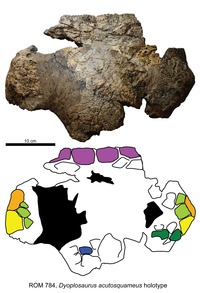 | |
| Edmontonia | E. rugosidens | Lower, 76.5-75.9 Ma ago | A partial skeleton including a skull, dorsal vertebrae, proximal, distal caudal, ribs, humerus, ulna, radius, manus, fragments of the pelvis, tibia, fibula?, osteoderms; anterior half of an articulated skeleton with in situ osteoderms, and paired first medial scutes. | A nodosaurine nodosaurid also known from the Horseshoe Canyon Formation and Two Medicine Formation |  | |
| Euoplocephalus | E. tutus | Lower to Middle, ~76.4-75.6 Ma ago | [Four] skulls, mandible, cervical vertebrae, dorsal vertebrae, ribs, scapulae, humeri, radius, ulna, metacarpals, phalanx, ilium, ischium, femur, tibia, partial pes, sacrum, cervical half-rings, and osteoderms. | An ankylosaurine ankylosaurid |  | |
| Panoplosaurus | P. mirus | Middle, 75.6 Ma ago | Skull with lower jaws, isolated teeth, cervical vertebrae, dorsal vertebrae, sacral vertebrae, cervical ribs, dorsal ribs, scapulocoracoid, humerus, manus, tibia, fibula, ossified intersternal plate, a pair of ossified xiphoid processes, pes, and in situ osteoderms. | A nodosaurine nodosaurid |  | |
| Platypelta | P. coombsi | Lower, 77.5-76.5 Ma ago | A well-preserved skull, mandibles, teeth, cervical and dorsal vertebrae, ribs, complete pelvis, both scapulocoracoids, both humeri and radii, both cervical half-rings, and osteoderms. | An ankylosaurine ankylosaurid |  | |
| Scolosaurus | S. cutleri | Lower, 76.5 Ma ago or more | A nearly complete skeleton, a skull, cervical, dorsal, and caudal vertebrae, ribs, scapula, coracoid, humeri, radii, ilium, ischium, femur, tibia, fibula, [one] cervical half-ring, and osteoderms. | An ankylosaurine ankylosaurid briefly thought to be synonymous with Euoplocephalus. It possibly came from the upper layers of the underlying Oldman Formation. |  | |
| S. thronus | Upper, 75 Ma ago | A partial skeleton including a skull, dorsal vertebrae, ?complete synsacrum, sacral ribs, caudal vertebrae, scapula, partial ilia, humerus, cervical half-rings, osteoderms, and skin impressions. | An ankylosaurine ankylosaurid | |||
Ceratopsians
An unnamed Pachyrhinosaurus-like taxon has been recovered from the formation.
| Ceratopsians from the Dinosaur Park Formation | ||||||
|---|---|---|---|---|---|---|
| Genus | Species | Location | Stratigraphic position | Material | Notes | Images |
| Centrosaurus | C. apertus | Middle, 76.2-75.5Ma ago | "[Fifteen] skulls, several skeletons, all adult; abundant bone-bed material with rare juveniles and subadults." C. nasicornis may be a synonym. | A centrosaurine ceratopsid | 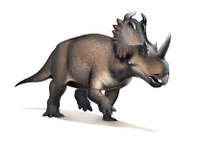 | |
| Chasmosaurus | C. belli | Middle, 76–75.5Ma ago | "[Twelve] skulls, several skeletons." | A chasmosaurine ceratopsid | 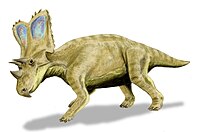 | |
| C. russelli | Lower, 76.5-76Ma ago | "[Six] complete or partial skulls." | ||||
| Mercuriceratops | M. gemini | Lower, ~77Ma ago | "one apomorphic squamosal" | A chasmosaurine ceratopsid |  | |
| Monoclonius | M. lowei | A dubious centrosaurine ceratopsid. Possibly synonymous with Centrosaurus. | ||||
| Pentaceratops | P. aquilonius | Uppermost, 74.8 MA | two frill fragments | A dubious chasmosaurine ceratopsid that may be the same species as Spiclypeus shipporum. |  | |
| Spinops | S. sternbergorum | Lower, 76.5Ma | "partial parietal bone, partial dentary, unidentifiable limb fragments, partial skull, and partial right squamosal." | A centrosaurine ceratopsid.It may actually be from the upper Oldman Formation. |  | |
| Styracosaurus | S. albertensis | Upper, 75.5-75.2Ma ago | "[Two] skulls, [three] skeletons, additional material in bone beds." | A centrosaurine ceratopsid |  | |
| Unescoceratops | U. koppelhusae | Partial lower jaw | A leptoceratopsid thought to have been between one and two meters long and less than 91 kilograms. Its teeth were the roundest of all leptoceratopsids. | |||
| Vagaceratops | V. irvinensis | Upper, 75Ma ago | "[Three] skulls, skeleton lacking tail." | A chasmosaurine ceratopsid species previously classified as a species of Chasmosaurus. | 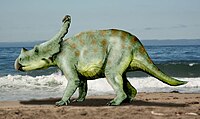 | |
Ornithopods
At least one indeterminate thescelosaurid specimen has been recovered from the formation.
In a 2001 review of hadrosaur eggshell and hatchling material from the Dinosaur Park Formation, Darren H. Tanke and M. K. Brett-Surman concluded that hadrosaurs nested in both the ancient upland and lowlands of the formation's depositional environment. The upland nesting grounds may have been preferred by the less common hadrosaurs, like Brachylophosaurus or Parasaurolophus. However, the authors were unable to determine what specific factors shaped nesting ground choice in the formation's hadrosaurs. They suggested that behavior, diet, soil condition, and competition between dinosaur species all potentially influenced where hadrosaurs nested.
Sub-centimeter fragments of pebbly-textured hadrosaur eggshell have been reported from the Dinosaur Park Formation. This eggshell is similar to the hadrosaur eggshell of Devil's Coulee in southern Alberta as well as that of the Two Medicine and Judith River Formations in Montana, United States. While present, dinosaur eggshell is very rare in the Dinosaur Park Formation and is only found in two different microfossil sites. These sites are distinguished by large numbers of pisidiid clams and other less common shelled invertebrates like unionid clams and snails. This association is not a coincidence as the invertebrate shells would have slowly dissolved and released enough basic calcium carbonate to protect the eggshells from naturally occurring acids that otherwise would have dissolved them and prevented fossilization.
In contrast with eggshell fossils, the remains of very young hadrosaurs are actually somewhat common. Darren Tanke has observed that an experienced collector could actually discover multiple juvenile hadrosaur specimens in a single day. The most common remains of young hadrosaurs in the Dinosaur Park Formation are dentaries, bones from limbs and feet, as well as vertebral centra. The material showed little or none of the abrasion that would have resulted from transport, meaning the fossils were buried near their point of origin. Bonebeds 23, 28, 47, and 50 are productive sources of young hadrosaur remains in the formation, especially bonebed 50. The bones of juvenile hadrosaurs and fossil eggshell fragments are not known to have preserved in association with each other, despite both being present in the formation.
| Ornithopods from the Dinosaur Park Formation | ||||||
|---|---|---|---|---|---|---|
| Genus | Species | Location | Stratigraphic position | Material | Notes | Images |
| Corythosaurus | C. casuarius | Lower-Middle, 76.5-75.5Ma ago | "Approximately [ten] articulated skulls and associated postcrania, [ten to fifteen] articulated skulls, isolated skull elements, juvenile to adult." | A lambeosaurin lambeosaurine hadrosaur |  | |
| Gryposaurus | G. notabilis | Lower, 76.2-76Ma ago | "Approximately [ten] complete skulls, [twelve] fragmentary skulls, associated postcrania." | A kritosaurin saurolophine hadrosaur |  | |
| Lambeosaurus | L. lambei | Upper, 75.5-75Ma ago | "Approximately [seven] articulated skulls with associated postcrania, [possibly ten] articulated skulls, isolated skull elements, juvenile to adult." |  | ||
| L. magnicristatus | Upper/Bearpaw Formation, 74.8Ma ago | "[Two] complete skulls, one with associated, articulated postcrania." | 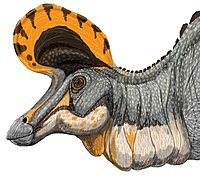 | |||
| Parasaurolophus | P. walkeri | Lower, 76.5-75.3Ma ago | "Complete skull and postcranial skeleton." | A parasaurolophin lambeosaurine hadrosaur. |  | |
| Prosaurolophus | P. maximus | Upper, 75.5 – 74.8 Ma | "[Twenty to twenty-five] individuals, including at least [seven] articulated skulls and associated postcrania." | A saurolophin saurolophine hadrosaur | 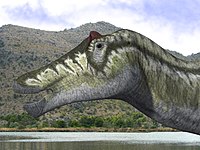 | |
Pachycephalosaurs
| Pachycephalosaurs from the Dinosaur Park Formation | ||||||
|---|---|---|---|---|---|---|
| Genus | Species | Location | Stratigraphic position | Material | Notes | Images |
|
F. brevis |
Also present in the Oldman Formation |
Frontoparetal dome, various other skull fragments including juvenile and subadult material |
Once thought to be a species of Stegoceras |
|||
|
G. albertae |
"Frontoparietal dome." |
Potentially synonymous with Stegoceras validum. |
 | |||
|
H. sternbergi |
Lower, also present in the Oldman Formation and Judith River Formation |
Potentially synonymous with Stegoceras validum. |
 | |||
|
S. lyonsi |
Upper, 76.10 ± 0.5 Ma |
Right squamosal |
||||
|
S. validum |
Specimens including frontoparietal dome. |
 | ||||
|
A nomen nudum. |
||||||
Theropods
In the Dinosaur Park Formation, small theropods are rare due to the tendency of their thin-walled bones to be broken or poorly preserved. Small bones of small theropods that were preyed upon by larger ones may have been swallowed whole and digested. In this context, the discovery of a small theropod dinosaur with preserved tooth marks was especially valuable. Possible indeterminate avimimid remains are known from the formation.
Ornithomimids
| Ornithomimids from the Dinosaur Park Formation | ||||||
|---|---|---|---|---|---|---|
| Genus | Species | Location | Stratigraphic position | Material | Notes | Images |
| Ornithomimus | O. sp. | Type specimen | An ornithomimid, possibly a species of Struthiomimus. |  | ||
| Qiupalong | Q. sp. | Several specimens | An ornithomimid, possibly a radiation of this genus from Asia. |  | ||
| Rativates | R. evadens | Type specimen | An ornithomimid, formerly a specimen of Struthiomimus. |  | ||
Oviraptorosaurs
Color key
|
Notes Uncertain or tentative taxa are in small text; |
| Oviraptorosaurs from the Dinosaur Park Formation | ||||||
|---|---|---|---|---|---|---|
| Genus | Species | Location | Stratigraphic position | Material | Notes | Images |
| Caenagnathus | C. collinsi | Mandible, type specimen | A caenagnathid which rivalled Anzu in size. | 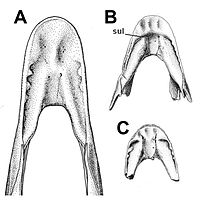 | ||
| Chirostenotes | C. pergracilis | Several fragmentary specimens, type specimen | A mid-sized caenagnathid. |  | ||
| Citipes | C. elegans | Several fragmentary specimens, type specimen | Smallest caenagnathid from the formation. |  | ||
| Macrophalangia | M. canadensis | Junior synonym of Chirostenotes pergracilis | ||||
Paravians
A new taxon of troodontid based solely on teeth is known from the upper part of the formation.
| Paravians from the Dinosaur Park Formation | ||||||
|---|---|---|---|---|---|---|
| Genus | Species | Location | Stratigraphic position | Material | Notes | Images |
| cf. Baptornis | Indeterminate | A hesperornithine bird | ||||
| cf. Cimolopteryx | Indeterminate | Partial coracoid | A possible charadriiform bird | |||
| Dromaeosaurus | D. albertensis | Several specimens and teeth, type specimen | A dromaeosaurid |  | ||
| Hesperonychus | H. elizabethae | Hip bones and partial toes and claws, type specimen | A dromaeosaurid or an avialan, also found in the Oldman Formation |  | ||
| Latenivenatrix | L. mcmasterae | Hip bones, pelvis, skull fragments, type specimen | A large troodontid measuring 3–3.5 m (9.8–11.5 ft). |  | ||
| cf. Palintropus | Unnamed | Partial shoulder girdles | An ambiortiform bird | |||
| cf. Paronychodon | cf. P. lacustris | Teeth | An indeterminate maniraptoran, also found in the Judith River | |||
| cf. Pectinodon | Indeterminate | Teeth | A troodont | |||
| Polyodontosaurus | P. grandis | Dentary, type specimen | Nomen dubium. Possibly synonymous with Latenivenatrix. | |||
| Richardoestesia | R. gilmorei | Mandible, type specimen | A dromaeosaurid | |||
| R. isosceles | Teeth | |||||
| Saurornitholestes | S. langstoni | Incomplete skeleton and teeth, type specimen. A dentary referred to Saurornitholestes was discovered that preserved tooth marks left by a young tyrannosaur. | A dromaeosaurid |  | ||
| Stenonychosaurus | S. inequalis | Nearly complete skeleton and other partial skeletons, type specimen | A troodontid once thought to be a species of Troodon |  | ||
Tyrannosaurs
| Tyrannosaurs from the Dinosaur Park Formation | ||||||
|---|---|---|---|---|---|---|
| Genus | Species | Location | Stratigraphic position | Material | Notes | Images |
| Daspletosaurus | D. wilsoni | Middle-Upper, ~75 Ma ago | Several specimens | A tyrannosaurine tyrannosaurid, also present in the Bearpaw Formation. | 
| |
| Gorgosaurus | G. libratus | Lower-Middle, 76.5–75 Ma ago | Numerous specimens, type specimen | An albertosaurine tyrannosaurid whose fossils have been unearthed in the Judith River Formation and possibly the Two Medicine Formation. It was the most common large carnivore in the area. |  | |
Color key
|
Notes Uncertain or tentative taxa are in small text; |
Other reptiles
Choristoderes
Choristoderes, or champsosaurs, were aquatic reptiles. Small examples looked like lizards, while larger types were superficially similar to crocodilians. Remains of the following Choristoderes have been found in the formation:
- Champsosaurus (at least 3 species)
- Cteniogenys sp. cf. antiquus (possibly another genus)
Crocodylians
Remains of the following Crocodylians have been found in the formation:
- Albertochampsa
- Leidyosuchus
- at least 1 unnamed taxon
Lizards
Remains of the following lizards have been found in the formation:
Plesiosaurs
Remains of the following Plesiosaurs have been found in the formation:
- Fluvionectes
- indeterminate polycotylids (shorter-necked)
Pterosaurs
Remains of the following pterosaurs have been found in the formation:
- Cryodrakon (known from small and large specimens)
- 1 unnamed non-azhdarchid pterosaur
Turtles
Remains of the following turtles have been found in the formation:
- Adocus
- "Apalone"
- Aspideretoides (3 species)
- Basilemys
- Boremys
- Judithemys
- Neurankylus
- Plesiobaena
- 2 indeterminate taxa
Mammals

Remains of the following mammals have been found in the formation:
- Multituberculata
- Cimexomys sp.
- Cimolodon spp.
- Cimolomys clarki
- Meniscoessus major
- Mesodma primaeva
- unnamed multituberculates
- Metatherians
- Alphadon halleyi
- Eodelphis browni
- E. cutleri
- 5 species of "Pediomys"
- Turgidodon russelli
- T. praesagus
- Eutherians
- Cimolestes sp. (uncertain taxonomy)
- Gypsonictops lewisi
- Paranyctoides sternbergi
- Unknown therians: at least 1 species
Fish
Remains of the following fish have been found in the formation:
- Chondrichthyans
- Cretorectolobus olsoni (a carpet shark)
- Eucrossorhinus microcuspidatus (a carpet shark)
- Ischyrhiza mira (a sclerorhynchid)
- Meristodonoides montanensis (a shark)
- Myledaphus bipartitus (a ray)
- Protoplatyrhina renae (a guitarfish)
- indeterminate orectolobid
- Acipenseriformes (sturgeons)
- "Acipenser albertensis"
- Anchiacipenser acanthaspis
- unnamed sturgeon
- unnamed paddlefish
- Holostean fish
- Lepisosteus occidentalis (the gar)
- unnamed bowfin
- at least 2 other holosteans
- Teleost fish
- Belonostomus longirostris
- Cretophareodus (an osteoglossomorph)
- Coriops amnicolus
- Estesesox foxi (a pike)
- Oldmanesox (a pike)
- Paralbula (including Phyllodus)
- Paratarpon apogerontus (an elopomorph, like the tarpon)
- Primuluchara (a characin)
- at least 8 other teleosts
Invertebrates
Remains of the following invertebrates have been found in the formation:
- Freshwater bivalves
- Freshwater gastropods
- Campeloma (2 species)
- Elimia
- Goniobasis (3 species)
- Hydrobia
- Lioplacodes (2 species)
Flora
Plant body fossils
The following plant body fossils have been found in the formation:
- various ferns
- Equisetum (Equisetaceae)
- Gymnosperms
- Platyspiroxylon (Cupressaceae)
- Podocarpoxylon (Podocarpaceae)
- Elatocladus (Taxodiaceae)
- Sequoia (Taxodiaceae)
- Sequoiaxylon (Taxodiaceae)
- Taxodioxylon (Taxodiaceae)
- Ginkgos
- Angiosperms
Palynomorphs
Palynomorphs are organic-walled microfossils, like spores, pollen, and algae. The following palynomorphs have been found in the formation:
- Unknown producers
- at least 8 species
- Fungi
- at least 35 taxa
- Chlorophyta (green algae and blue-green algae)
- at least 12 species
- Pyrrhophyta (dinoflagellates, a type of marine algae)
- unassigned cysts
- Bryophytes (mosses, liverworts, and hornworts)
- Anthocerotophyta (hornworts)
- at least 5 species
- Marchantiophyta (liverworts)
- at least 14 species
- Bryophyta (mosses)
- at least 5 species
- Anthocerotophyta (hornworts)
- Lycopodiophyta
- Lycopodiaceae (club mosses)
- at least 11 species
- Selaginellaceae (small club mosses)
- at least 6 species
- Isoetaceae (quillworts)
- at least 1 species
- Lycopodiaceae (club mosses)
- Polypodiophyta
- Osmundaceae (cinnamon ferns)
- at least 6 species
- Schizaeaceae (climbing ferns)
- at least 20 species
- Gleicheniaceae (Gleichenia and allies; coral ferns)
- at least 5 species
- Cyatheaceae (Cyathea and allies)
- at least 4 species
- Dicksoniaceae (Dicksonia and allies)
- at least 3 species
- Polypodiaceae (ferns)
- at least 4 species
- Matoniaceae
- at least 1 species
- Marsileaceae
- at least 1 species
- Osmundaceae (cinnamon ferns)
- Pinophyta (gymnosperms)
- Cycadaceae (cycads)
- at least 3 species
- Caytoniaceae
- at least 1 species
- Pinaceae (pines)
- at least 4 species
- Cupressaceae (cypresses)
- at least 3 species
- Podocarpaceae (Podocarpus and allies)
- at least 4 species
- Cheirolepidiaceae
- at least 2 species
- Ephedraceae (Mormon teas)
- at least 6 species
- Unknown gymnosperms: at least 3 species
- Cycadaceae (cycads)
- Magnoliophyta (angiosperms)
- Magnoliopsida (dicots)
- Buxaceae (boxwood)
- at least 1 species
- Gunneraceae (gunneras)
- at least 1 species
- Salicaceae (willows, cottonwood, quaking aspen)
- at least 1 species
- Droseraceae (sundews)
- at least 1 species
- Olacaceae (tallowwood)
- at least 2 species
- Loranthaceae (showy mistletoes)
- at least 1 species
- Sapindaceae (soapberry)
- at least 1 species
- Aceraceae (maples)
- at least 1 species
- Proteaceae (proteas)
- at least 9 species
- Compositae (sunflowers)
- at least 1 species
- Fagaceae (beeches, oaks, chestnuts)
- at least 2 species
- Betulaceae (birches, alders)
- at least 1 species
- Ulmaceae (elms)
- at least 1 species
- Chenopodiaceae (goosefoots)
- at least 1 species
- Buxaceae (boxwood)
- Liliopsida (monocots)
- Liliaceae (lilies)
- at least 6 species
- Cyperaceae (sedges)
- at least 1 species
- Sparganiaceae (bur-reeds)
- possibly 1 species
- Unknown angiosperms: at least 88 species
- Liliaceae (lilies)
- Magnoliopsida (dicots)
Timeline of new taxa
The following timeline displays valid taxa first discovered in the dinosaur park formation. Some species may have been referred to other genera subsequent to their initial description.

See also
Footnotes
- ^ Lexicon of Canadian Geologic Units: Dinosaur Park Formation Archived 2013-02-21 at archive.today
- ^ Eberth, D.A.; Hamblin, A.P. (1993). "Tectonic, stratigraphic, and sedimentologic significance of a regional discontinuity in the upper Judith River Group (Belly River wedge) of southern Alberta, Saskatchewan, and northern Montana". Canadian Journal of Earth Sciences. 30 (1): 174–200. Bibcode:1993CaJES..30..174E. doi:10.1139/e93-016.
- ^ Ramezani, Jahandar; Beveridge, Tegan L.; Rogers, Raymond R.; Eberth, David A.; Roberts, Eric M. (2022-09-26). "Calibrating the zenith of dinosaur diversity in the Campanian of the Western Interior Basin by CA-ID-TIMS U–Pb geochronology". Scientific Reports. 12 (1): 16026. Bibcode:2022NatSR..1216026R. doi:10.1038/s41598-022-19896-w. ISSN 2045-2322. PMC 9512893. PMID 36163377.
- ^ Eberth, D.A. 2005. The geology. In: Currie, P.J., and Koppelhus, E.B. (eds), Dinosaur Provincial Park: A Spectacular Ancient Ecosystem Revealed. Indiana University Press: Bloomington and Indianapolis, p.54-82. ISBN 0-253-34595-2.
- ^ Currie, P.J., and Koppelhus, E.B. (eds), Dinosaur Provincial Park: A Spectacular Ancient Ecosystem Revealed. Indiana University Press: Bloomington and Indianapolis, p. 277-291. ISBN 0-253-34595-2.
- ^ Mallon, Jordan C.; S, Jason (2012). "Megaherbivorous dinosaur turnover in the Dinosaur Park Formation (upper Campanian) of Alberta, Canada". Palaeogeography, Palaeoclimatology, Palaeoecology. 350–352: 124–138. Bibcode:2012PPP...350..124M. doi:10.1016/j.palaeo.2012.06.024.
- ^ Ryan and Evans (2005).
- ^ Evans D.C.; Bavington R.; Campione N.E. (2009). "An unusual hadrosaurid braincase from the Dinosaur Park Formation and the biostratigraphy of Parasaurolophus (Ornithischia: Lambeosaurinae) from southern Alberta". Canadian Journal of Earth Sciences. 46 (11): 791–800. Bibcode:2009CaJES..46..791E. doi:10.1139/E09-050.
- ^ Fowler, Denver Warwick (2017-11-22). "Revised geochronology, correlation, and dinosaur stratigraphic ranges of the Santonian-Maastrichtian (Late Cretaceous) formations of the Western Interior of North America". PLOS ONE. 12 (11): e0188426. Bibcode:2017PLoSO..1288426F. doi:10.1371/journal.pone.0188426. ISSN 1932-6203. PMC 5699823. PMID 29166406.
- ^ Arbour, V. M.; Burns, M. E.; Sissons, R. L. (2009). "A redescription of the ankylosaurid dinosaur Dyoplosaurus acutosquameus Parks, 1924 (Ornithischia: Ankylosauria) and a revision of the genus". Journal of Vertebrate Paleontology. 29 (4): 1117–1135. Bibcode:2009JVPal..29.1117A. doi:10.1671/039.029.0405. S2CID 85665879.
- ^ Penkalski, P. (2013). "A new ankylosaurid from the late Cretaceous Two Medicine Formation of Montana, USA". Acta Palaeontologica Polonica. doi:10.4202/app.2012.0125.
- ^ Mallon, J. C., Evans, D. C., Ryan, M. J., & Anderson, J. S. (2012). Megaherbivorous dinosaur turnover in the Dinosaur Park Formation (upper Campanian) of Alberta, Canada. Palaeogeography, Palaeoclimatology, Palaeoecology.
- ^ Gardner, J.D. 2005. Lissamphibians. In: Currie, P.J., and Koppelhus, E.B. (eds), Dinosaur Provincial Park: A Spectacular Ancient Ecosystem Revealed. Indiana University Press: Bloomington and Indianapolis, p. 186-201. ISBN 0-253-34595-2.
- ^ "Fossilworks: Gateway to the Paleobiology Database". fossilworks.org. Retrieved 17 December 2021.
- ^ "Fossilworks: Gateway to the Paleobiology Database". fossilworks.org. Retrieved 17 December 2021.
- ^ Currie, P.J. 2005. Theropods, including birds. In: Currie, P.J., and Koppelhus, E.B. (eds), Dinosaur Provincial Park: A Spectacular Ancient Ecosystem Revealed. Indiana University Press: Bloomington and Indianapolis, p. 367-397. ISBN 0-253-34595-2.
- ^ Ryan, M.J., and Evans, D.C. 2005. Ornithischian dinosaurs. In: Currie, P.J., and Koppelhus, E.B. (eds), Dinosaur Provincial Park: A Spectacular Ancient Ecosystem Revealed. Indiana University Press: Bloomington and Indianapolis, p. 312-348. ISBN 0-253-34595-2.
- ^ Penkalski, Paul (2018). "Revised systematics of the armoured dinosaur Euoplocephalus and its allies". Neues Jahrbuch für Geologie und Paläontologie - Abhandlungen. 287 (3): 261–306. doi:10.1127/njgpa/2018/0717.
- ^ "Table 17.1," in Weishampel, et al. (2004). Page 365.
- ^ Penkalski, Paul (2013). "A new ankylosaurid from the late Cretaceous Two Medicine Formation of Montana, USA". Acta Palaeontologica Polonica. doi:10.4202/app.2012.0125.
- ^ Ryan, Michael; Eberth, David; Brinkman, Donald; Currie, Philip; Tanke, Darren (January 2010). New Perspectives on Horned Dinosaurs. pp. 141–155. Retrieved 16 January 2022.
- ^ "Table 23.1," in Weishampel, et al. (2004). Page 495.
- ^ RYAN, M. J.; RUSSELL, A. P.; EBERTH, D. A.; CURRIE, P. J. (2001-10-01). "The Taphonomy of a Centrosaurus (Ornithischia: Certopsidae) Bone Bed from the Dinosaur Park Formation (Upper Campanian), Alberta, Canada, with Comments on Cranial Ontogeny". PALAIOS. 16 (5): 482–506. Bibcode:2001Palai..16..482R. doi:10.1669/0883-1351(2001)016<0482:ttoaco>2.0.co;2. ISSN 0883-1351. S2CID 130116586.
- ^ "Table 23.1," in Weishampel, et al. (2004). Page 496.
- ^ Ryan, Michael J.; Evans, David C.; Currie, Phillip J.; Loewen, Mark A. (2014). "A New chasmosaurine from northern Laramidia expands frill disparity in ceratopsid dinosaurs". Naturwissenschaften. 101 (6): 505–512. Bibcode:2014NW....101..505R. doi:10.1007/s00114-014-1183-1. PMID 24859020. S2CID 13957187.
- ^ Nicholas R. Longrich (2014). "The horned dinosaurs Pentaceratops and Kosmoceratops from the upper Campanian of Alberta and implications for dinosaur biogeography". Cretaceous Research. 51: 292–308. Bibcode:2014CrRes..51..292L. doi:10.1016/j.cretres.2014.06.011.
- ^ Jordan C. Mallon; Christopher J. Ott; Peter L. Larson; Edward M. Iuliano; David C. Evans (2016). "Spiclypeus shipporum gen. et sp. nov., a Boldly Audacious New Chasmosaurine Ceratopsid (Dinosauria: Ornithischia) from the Judith River Formation (Upper Cretaceous: Campanian) of Montana, USA". PLOS ONE. 11 (5): e0154218. Bibcode:2016PLoSO..1154218M. doi:10.1371/journal.pone.0154218. PMC 4871577. PMID 27191389.
- ^ Farke, Andrew A.; Michael J. Ryan; Paul M. Barrett; Darren H. Tanke; Dennis R. Braman; Mark A. Loewen; Mark R. Graham (2011). "A new centrosaurine from the Late Cretaceous of Alberta, Canada, and the evolution of parietal ornamentation in horned dinosaurs" (PDF). Acta Palaeontologica Polonica. 56 (4): 691–702. doi:10.4202/app.2010.0121. S2CID 13717580.
- ^ Michael J. Ryan; David C. Evans; Philip J. Currie; Caleb M. Brown; Don Brinkman (2012). "New leptoceratopsids from the Upper Cretaceous of Alberta, Canada". Cretaceous Research. 35: 69–80. Bibcode:2012CrRes..35...69R. doi:10.1016/j.cretres.2011.11.018.
- ^ Scott D. Sampson; Mark A. Loewen; Andrew A. Farke; Eric M. Roberts; Catherine A. Forster; Joshua A. Smith; Alan L. Titus (2010). "New Horned Dinosaurs from Utah Provide Evidence for Intracontinental Dinosaur Endemism". PLOS ONE. 5 (9): e12292. Bibcode:2010PLoSO...512292S. doi:10.1371/journal.pone.0012292. PMC 2929175. PMID 20877459.
- ^ "Abstract," Tanke and Brett-Surman (2001). Page 206.
- ^ "Conclusions," Tanke and Brett-Surman (2001). Page 212.
- ^ "Eggshell," Tanke and Brett-Surman (2001). Page 209.
- ^ "Introduction," Tanke and Brett-Surman (2001). Page 208.
- ^ "Discussion," Tanke and Brett-Surman (2001). Page 212.
- ^ "Table 20.1," in Weishampel, et al. (2004). Page 441.
- ^ "Table 20.1," in Weishampel, et al. (2004). Page 440.
- ^ "Table 20.1," in Weishampel, et al. (2004). Page 442.
- ^ "Table 21.1," in Weishampel, et al. (2004). Page 465.
- ^ Dyer, Aaron D.; Powers, Mark J.; Currie, Philip J. (2023). "Problematic putative pachycephalosaurids: Synchrotron µCT imaging shines new light on the anatomy and taxonomic validity of Gravitholus albertae from the Belly River Group (Campanian) of Alberta, Canada". Vertebrate Anatomy Morphology Palaeontology. 10 (1): 65–110. doi:10.18435/vamp29388. ISSN 2292-1389.
- ^ Woodruff, D. Cary; Schott, Ryan K.; Evans, David C. (2023-11-15). "Two new species of small-bodied pachycephalosaurine (Dinosauria, Marginocephalia) from the uppermost Cretaceous of North America suggest hidden diversity in well-sampled formations". Papers in Palaeontology. 9 (6). e1535. Bibcode:2023PPal....9E1535W. doi:10.1002/spp2.1535. ISSN 2056-2799.
- ^ "Introduction," Jacobsen (2001). Page 59.
- ^ "Discussion," Jacobsen (2001). Page 61.
- ^ Longrich, N. R. (2014). "The horned dinosaurs Pentaceratops and Kosmoceratops from the upper Campanian of Alberta and implications for dinosaur biogeography". Cretaceous Research. 51: 292. Bibcode:2014CrRes..51..292L. doi:10.1016/j.cretres.2014.06.011.
- ^ Longrich, N (2008). "A new, large ornithomimid from the Cretaceous Dinosaur Park Formation of Alberta, Canada: Implications for the study of dissociated dinosaur remains". Palaeontology. 51 (4): 983–997. Bibcode:2008Palgy..51..983L. doi:10.1111/j.1475-4983.2008.00791.x.
- ^ McFeeters, B.; Ryan, M. J.; Schröder-Adams, C.; Currie, P. J. (2017). "First North American occurrences of Qiupalong (Theropoda: Ornithomimidae) and the palaeobiogeography of derived ornithomimids". FACETS. 2 (1): 355–373. doi:10.1139/facets-2016-0074.
- ^ McFeeters, B.; et al. (2016). "A new ornithomimid theropod from the Dinosaur Park Formation of Alberta, Canada". Journal of Vertebrate Paleontology. 36 (6): e1221415. Bibcode:2016JVPal..36E1415M. doi:10.1080/02724634.2016.1221415. S2CID 89242374.
- ^ Longrich, N. R.; Barnes, K.; Clark, S.; Millar, L. (2013). "Caenagnathidae from the Upper Campanian Aguja Formation of West Texas, and a Revision of the Caenagnathinae". Bulletin of the Peabody Museum of Natural History. 54: 23–49. doi:10.3374/014.054.0102. S2CID 128444961.
- ^ Funston, Gregory (2020-07-27). "Caenagnathids of the Dinosaur Park Formation (Campanian) of Alberta, Canada: anatomy, osteohistology, taxonomy, and evolution". Vertebrate Anatomy Morphology Palaeontology. 8: 105–153. doi:10.18435/vamp29362. ISSN 2292-1389.
- ^ Sankey, Julia T.; Brinkman, Donald B.; Guenther, Merrilee; Currie, Philip J. (2002). "Small Theropod and Bird Teeth from the Late Cretaceous (Late Campanian) Judith River Group, Alberta". Journal of Paleontology. 76 (4): 751–763. CiteSeerX 10.1.1.959.1946. doi:10.1666/0022-3360(2002)076<0751:STABTF>2.0.CO;2. ISSN 0022-3360. S2CID 85973327.
- ^ Hartman, Scott; Mortimer, Mickey; Wahl, William R.; Lomax, Dean R.; Lippincott, Jessica; Lovelace, David M. (2019-07-10). "A new paravian dinosaur from the Late Jurassic of North America supports a late acquisition of avian flight". PeerJ. 7: e7247. doi:10.7717/peerj.7247. ISSN 2167-8359. PMC 6626525. PMID 31333906.
- ^ Jasinski, Steven E.; Sullivan, Robert M.; Dodson, Peter (December 2020). "New Dromaeosaurid Dinosaur (Theropoda, Dromaeosauridae) from New Mexico and Biodiversity of Dromaeosaurids at the end of the Cretaceous". Scientific Reports. 10 (1): 5105. Bibcode:2020NatSR..10.5105J. doi:10.1038/s41598-020-61480-7. PMC 7099077. PMID 32218481.
- ^ Currie, Philip J.; Larson, Derek W. (2013-01-23). "Multivariate Analyses of Small Theropod Dinosaur Teeth and Implications for Paleoecological Turnover through Time". PLOS ONE. 8 (1): e54329. Bibcode:2013PLoSO...854329L. doi:10.1371/journal.pone.0054329. ISSN 1932-6203. PMC 3553132. PMID 23372708.
- ^ "Abstract," Jacobsen (2001). Page 58.
- ^ Warshaw, E. A.; Barrera Guevara, D.; Fowler, D. W. (2024). "Anagenesis and the tyrant pedigree: a response to "Re-analysis of a dataset refutes claims of anagenesis within Tyrannosaurus-line tyrannosaurines (Theropoda, Tyrannosauridae)"". Cretaceous Research. 163. 105957. doi:10.1016/j.cretres.2024.105957.
- ^ Currie, Philip J. (2003). "Cranial anatomy of tyrannosaurids from the Late Cretaceous of Alberta". Acta Palaeontologica Polonica. 48 (2): 191–226.
- ^ Yun, Changyu (January 2021). Fossil record 7: NMMNH Bulletin 82. New Mexico Museum of Natural History and Science. pp. 569–578. Retrieved 12 January 2022.
- ^ K.Gao and Brinkman, D.B. 2005. Choristoderes from the Park and its vicinity. In: Currie, P.J., and Koppelhus, E.B. (eds), Dinosaur Provincial Park: A Spectacular Ancient Ecosystem Revealed. Indiana University Press: Bloomington and Indianapolis, p. 221-234. ISBN 0-253-34595-2.
- ^ Xiao-Chun Wu. 2005. Crocodylians. In: Currie, P.J., and Koppelhus, E.B. (eds), Dinosaur Provincial Park: A Spectacular Ancient Ecosystem Revealed. Indiana University Press: Bloomington and Indianapolis, p. 277-291. ISBN 0-253-34595-2.
- ^ Caldwell, M.W. The squamates: origins, phylogeny, and paleoecology. In: Currie, P.J., and Koppelhus, E.B. (eds). 2005. Dinosaur Provincial Park: A Spectacular Ancient Ecosystem Revealed. Indiana University Press: Bloomington and Indianapolis, p. 235-248. ISBN 0-253-34595-2.
- ^ Sato, T., Eberth, D.A., Nicholls, E.L., and Manabe, M. 2005. Plesiosaurian remains from non-marine to paralic sediments. In: Currie, P.J., and Koppelhus, E.B. (eds), Dinosaur Provincial Park: A Spectacular Ancient Ecosystem Revealed. Indiana University Press: Bloomington and Indianapolis, p. 249-276. ISBN 0-253-34595-2.
- ^ Godfrey, S.J., and Currie, P.J. 2005. Pterosaurs. In: Currie, P.J., and Koppelhus, E.B. (eds), Dinosaur Provincial Park: A Spectacular Ancient Ecosystem Revealed. Indiana University Press: Bloomington and Indianapolis, p. 292-311. ISBN 0-253-34595-2.
- ^ David W. E. Hone; Michael B. Habib; François Therrien (2019). "Cryodrakon boreas gen. et sp. nov. a Late Cretaceous Canadian azhdarchid pterosaur". Journal of Vertebrate Paleontology. 39 (3): e1649681. Bibcode:2019JVPal..39E9681H. doi:10.1080/02724634.2019.1649681. S2CID 203406859.
- ^ Brinkman, D.B. 2005. Turtles: diversity, paleoecology, and distribution. In: Currie, P.J., and Koppelhus, E.B. (eds), Dinosaur Provincial Park: A Spectacular Ancient Ecosystem Revealed. Indiana University Press: Bloomington and Indianapolis, p. 202-220. ISBN 0-253-34595-2.
- ^ Fox, R.C. 2005. Late Cretaceous mammals. In: Currie, P.J., and Koppelhus, E.B. (eds), Dinosaur Provincial Park: A Spectacular Ancient Ecosystem Revealed. Indiana University Press: Bloomington and Indianapolis, p. 417-435. ISBN 0-253-34595-2.
- ^ Neuman, A.G., and Brinkman, D.B. 2005. Fishes of the fluvial beds. In: Currie, P.J., and Koppelhus, E.B. (eds), Dinosaur Provincial Park: A Spectacular Ancient Ecosystem Revealed. Indiana University Press: Bloomington and Indianapolis, p. 167-185. ISBN 0-253-34595-2.
- ^ "Fossilworks: Gateway to the Paleobiology Database". fossilworks.org. Retrieved 17 December 2021.
- ^ Hiroki Sato; Alison M. Murray; Oksana Vernygora; Philip J. Currie (2018). "A rare, articulated sturgeon (Chondrostei: Acipenseriformes) from the Upper Cretaceous of Dinosaur Provincial Park, Alberta, Canada". Journal of Vertebrate Paleontology. 38 (4): (1)-(15). doi:10.1080/02724634.2018.1488137. S2CID 92574712.
- ^ Newbrey, M. G.; Murray, A. M.; Wilson, M. V. H.; Brinkman, D. B.; Neuman, A. G. (2009-11-07). "Seventy-five-million-year-old tropical tetra-like fish from Canada tracks Cretaceous global warming". Proceedings of the Royal Society B: Biological Sciences. 276 (1674): 3829–3833. doi:10.1098/rspb.2009.1047. ISSN 0962-8452. PMC 2817284. PMID 19675010.
- ^ Wick, Steven L. (2021). "New early Campanian characiform fishes (Otophysi: Characiformes) from West Texas support a South American origin for known Late Cretaceous characiforms from North America". Cretaceous Research. 128: 104993. Bibcode:2021CrRes.12804993W. doi:10.1016/j.cretres.2021.104993.
- ^ Johnston, P.A., and Hendy, A.J.W. 2005. Paleoecology of mollusks from the Upper Cretaceous Belly River Group. In: Currie, P.J., and Koppelhus, E.B. (eds), Dinosaur Provincial Park: A Spectacular Ancient Ecosystem Revealed. Indiana University Press: Bloomington and Indianapolis, p. 139-166. ISBN 0-253-34595-2.
- ^ Koppelhus, E.B. 2005. Paleobotany. In: Currie, P.J., and Koppelhus, E.B. (eds), Dinosaur Provincial Park: A Spectacular Ancient Ecosystem Revealed. Indiana University Press: Bloomington and Indianapolis, p. 131-138. ISBN 0-253-34595-2.
- ^ Braman, D.R., and Koppelhus, E.B. 2005. Campanian palynomorphs. In: Currie, P.J., and Koppelhus, E.B. (eds), Dinosaur Provincial Park: A Spectacular Ancient Ecosystem Revealed. Indiana University Press: Bloomington and Indianapolis, p. 101-130. ISBN 0-253-34595-2.
References
- Arbour, V. M.; Burns, M. E.; Sissons, R. L. (2009). "A redescription of the ankylosaurid dinosaur Dyoplosaurus acutosquameus Parks, 1924 (Ornithischia: Ankylosauria) and a revision of the genus". Journal of Vertebrate Paleontology. 29 (4): 1117–1135. Bibcode:2009JVPal..29.1117A. doi:10.1671/039.029.0405. S2CID 85665879.
- Braman, D.R., and Koppelhus, E.B. 2005. Campanian palynomorphs. In: Currie, P.J., and Koppelhus, E.B. (eds), Dinosaur Provincial Park: A Spectacular Ancient Ecosystem Revealed. Indiana University Press: Bloomington and Indianapolis, 101–130.
- Brinkman, D.B. 2005. Turtles: diversity, paleoecology, and distribution. In: Currie, P.J., and Koppelhus, E.B. (eds), Dinosaur Provincial Park: A Spectacular Ancient Ecosystem Revealed. Indiana University Press: Bloomington and Indianapolis, 202–220.
- Caldwell, M.W. The squamates: origins, phylogeny, and paleoecology. In: Currie, P.J., and Koppelhus, E.B. (eds). 2005. Dinosaur Provincial Park: A Spectacular Ancient Ecosystem Revealed. Indiana University Press: Bloomington and Indianapolis, 235–248.
- Currie, P.J. 2005. Theropods, including birds. In: Currie, P.J., and Koppelhus, E.B. (eds), Dinosaur Provincial Park: A Spectacular Ancient Ecosystem Revealed. Indiana University Press: Bloomington and Indianapolis, 367–397.
- Currie, P.J., and Koppelhus, E.B. (eds). 2005. Dinosaur Provincial Park: A Spectacular Ancient Ecosystem Revealed. Indiana University Press: Bloomington and Indianapolis, 648 p.
- Eberth, D.A. 2005. The geology. In: Currie, P.J., and Koppelhus, E.B. (eds), Dinosaur Provincial Park: A Spectacular Ancient Ecosystem Revealed. Indiana University Press: Bloomington and Indianapolis, 54–82.
- Fox, R.C. 2005. Late Cretaceous mammals. In: Currie, P.J., and Koppelhus, E.B. (eds), Dinosaur Provincial Park: A Spectacular Ancient Ecosystem Revealed. Indiana University Press: Bloomington and Indianapolis, 417–435.
- K. Gao and Brinkman, D.B. 2005. Choristoderes from the Park and its vicinity. In: Currie, P.J., and Koppelhus, E.B. (eds), Dinosaur Provincial Park: A Spectacular Ancient Ecosystem Revealed. Indiana University Press: Bloomington and Indianapolis, 221–234.
- Gardner, J.D. 2005. Lissamphibians. In: Currie, P.J., and Koppelhus, E.B. (eds), Dinosaur Provincial Park: A Spectacular Ancient Ecosystem Revealed. Indiana University Press: Bloomington and Indianapolis, 186–201.
- Godfrey, S.J., and Currie, P.J. 2005. Pterosaurs. In: Currie, P.J., and Koppelhus, E.B. (eds), Dinosaur Provincial Park: A Spectacular Ancient Ecosystem Revealed. Indiana University Press: Bloomington and Indianapolis, 292–311.
- Johnston, P.A., and Hendy, A.J.W. 2005. Paleoecology of mollusks from the Upper Cretaceous Belly River Group. In: Currie, P.J., and Koppelhus, E.B. (eds), Dinosaur Provincial Park: A Spectacular Ancient Ecosystem Revealed. Indiana University Press: Bloomington and Indianapolis, 139–166.
- Koppelhus, E.B. 2005. Paleobotany. In: Currie, P.J., and Koppelhus, E.B. (eds), Dinosaur Provincial Park: A Spectacular Ancient Ecosystem Revealed. Indiana University Press: Bloomington and Indianapolis, 131–138.
- Lexicon of Canadian Geologic Units. "Dinosaur Park Formation". Archived from the original on 2013-02-21. Retrieved 2011-03-29.
- Neuman, A.G., and Brinkman, D.B. 2005. Fishes of the fluvial beds. In: Currie, P.J., and Koppelhus, E.B. (eds), Dinosaur Provincial Park: A Spectacular Ancient Ecosystem Revealed. Indiana University Press: Bloomington and Indianapolis, 167–185.
- Ryan, M.J., and Evans, D.C. 2005. Ornithischian dinosaurs. In: Currie, P.J., and Koppelhus, E.B. (eds), Dinosaur Provincial Park: A Spectacular Ancient Ecosystem Revealed. Indiana University Press: Bloomington and Indianapolis, 312–348.
- Sato, T., Eberth, D.A., Nicholls, E.L., and Manabe, M. 2005. Plesiosaurian remains from non-marine to paralic sediments. In: Currie, P.J., and Koppelhus, E.B. (eds), Dinosaur Provincial Park: A Spectacular Ancient Ecosystem Revealed. Indiana University Press: Bloomington and Indianapolis, 249–276.
- Tanke, D.H. and Brett-Surman, M.K. 2001. Evidence of Hatchling and Nestling-Size Hadrosaurs (Reptilia:Ornithischia) from Dinosaur Provincial Park (Dinosaur Park Formation: Campanian), Alberta, Canada. pp. 206–218. In: Mesozoic Vertebrate Life—New Research Inspired by the Paleontology of Philip J. Currie. Edited by D.H. Tanke and K. Carpenter. Indiana University Press: Bloomington. xviii + 577 pp.
- Xiao-Chun Wu. 2005. Crocodylians. In: Currie, P.J., and Koppelhus, E.B. (eds), Dinosaur Provincial Park: A Spectacular Ancient Ecosystem Revealed. Indiana University Press: Bloomington and Indianapolis, 277-291
